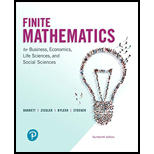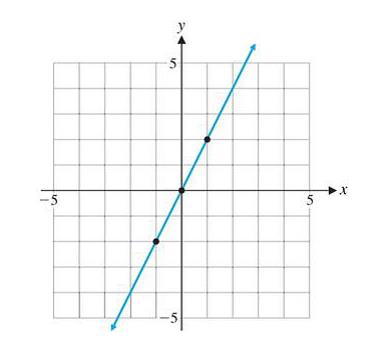Problem 1ED: To graph the equation y=x3+3x, we use point-by-point plotting to obtain the graph in Figure. (A) Do... Problem 2ED Problem 1MP: Sketch the graph of each equation. (A) y=x24 (B) y2=100x2+1 Problem 2MP: Determine which of the following equations specify functions with independent variable x. Ay2x4=9, x... Problem 3MP: Find the domain of the function specified by the equation y=x2, assuming x is the independent... Problem 4MP: Use the functions in Example 4 to find Af2Bg1Ch8Df3h5 Problem 5MP: Find the domains of functions F,G,andH : Fx=x23x+1Gx=5x+3Hx=2x Problem 6MP: Repeat Example 6 for fx=x24x+9. Using Function Notation, find (A) fa (B) fa+h (C) fa+h (D)... Problem 7MP: The financial department using statistical techniques, produced the data in Table, where Cx is the... Problem 1E: In Problems 1-8, use point-by-point plotting to sketch the graph of each equation. y=x+1 Problem 2E: In Problems 1-8, use point-by-point plotting to sketch the graph of each equation. x=y+1 Problem 3E: In Problems 1-8, use point-by-point plotting to sketch the graph of each equation. x=y2 Problem 4E: In Problems 1-8, use point-by-point plotting to sketch the graph of each equation. y=x2 Problem 5E: In Problems 1-8, use point-by-point plotting to sketch the graph of each equation. y=x3 Problem 6E: In Problems 1-8, use point-by-point plotting to sketch the graph of each equation. x=y3 Problem 7E: In Problems 1-8, use point-by-point plotting to sketch the graph of each equation. xy=6 Problem 8E: In Problems 1-8, use point-by-point plotting to sketch the graph of each equation. xy=12 Problem 9E: Indicate whether each table in Problems 9-14 specifies a function. Problem 10E: Indicate whether each table in Problems 9-14 specifies a function. Problem 11E: Indicate whether each table in Problems 9-14 specifies a function. Problem 12E: Indicate whether each table in Problems 9-14 specifies a function. Problem 13E: Indicate whether each table in Problems 9-14 specifies a function. Problem 14E: Indicate whether each table in Problems 9-14 specifies a function. Problem 15E: Indicate whether each graph in Problems 15-20 specifies a function. Problem 16E: Indicate whether each graph in Problems 15-20 specifies a function. Problem 17E: Indicate whether each graph in Problems 15-20 specifies a function. Problem 18E: Indicate whether each graph in Problems 15-20 specifies a function. Problem 19E: Indicate whether each graph in Problems 15-20 specifies a function. Problem 20E: Indicate whether each graph in Problems 15-20 specifies a function. Problem 21E: In Problems 21-28, each equation specifies a function with independent variable x. Determine whether... Problem 22E: In Problems 21-28, each equation specifies a function with independent variable x. Determine whether... Problem 23E: In Problems 21-28, each equation specifies a function with independent variable x. Determine whether... Problem 24E: In Problems 21-28, each equation specifies a function with independent variable x. Determine whether... Problem 25E: In Problems 21-28, each equation specifies a function with independent variable x. Determine whether... Problem 26E: In Problems 21-28, each equation specifies a function with independent variable x. Determine whether... Problem 27E: In Problems 21-28, each equation specifies a function with independent variable x. Determine whether... Problem 28E: In Problems 21-28, each equation specifies a function with independent variable x. Determine whether... Problem 29E: In Problems 29-36, use point-by-point plotting to sketch the graph of each function. fx=1x Problem 30E: In Problems 29-36, use point-by-point plotting to sketch the graph of each function. fx=x23 Problem 31E: In Problems 29-36, use point-by-point plotting to sketch the graph of each function. fx=x21 Problem 32E: In Problems 29-36, use point-by-point plotting to sketch the graph of each function. fx=3x2 Problem 33E: In Problems 29-36, use point-by-point plotting to sketch the graph of each function. fx=4x3 Problem 34E: In Problems 29-36, use point-by-point plotting to sketch the graph of each function. fx=x32 Problem 35E: In Problems 29-36, use point-by-point plotting to sketch the graph of each function. fx=8x Problem 36E: In Problems 29-36, use point-by-point plotting to sketch the graph of each function. fx=6x Problem 37E: In Problems 37 and 38, the three points in the table are on the graph of the indicated function f.... Problem 38E: In Problems 37 and 38, the three points in the table are on the graph of the indicated function f.... Problem 39E: In Problems 39-46, use the following graph of a function f to determine x or y to the nearest... Problem 40E: In Problems 39-46, use the following graph of a function f to determine x or y to the nearest... Problem 41E: In Problems 39-46, use the following graph of a function f to determine x or y to the nearest... Problem 42E: In Problems 39-46, use the following graph of a function f to determine x or y to the nearest... Problem 43E: In Problems 39-46, use the following graph of a function f to determine x or y to the nearest... Problem 44E: In Problems 39-46, use the following graph of a function f to determine x or y to the nearest... Problem 45E: In Problems 39-46, use the following graph of a function f to determine x or y to the nearest... Problem 46E: In Problems 39-46, use the following graph of a function f to determine x or y to the nearest... Problem 47E: In Problems 47-52, find the domain of each function. Fx=2x3x2+3 Problem 48E: In Problems 47-52, find the domain of each function. Hx=72x2x4 Problem 49E: In Problems 47-52, find the domain of each function. fx=x2x+4 Problem 50E: In Problems 47-52,find the domain of each function. gx=x+1x2 Problem 51E: In Problems 47-52,find the domain of each function. gx=7x Problem 52E: In Problems 47-52, find the domain of each function. Fx=15+x Problem 53E: In Problems 53-60, does the equation specify a function with independent variable x ? If so, find... Problem 54E: In Problems 53-60, does the equation specify a function with independent variable x ? If so, find... Problem 55E: In Problems 53-60, does the equation specify a function with independent variable x ? If so, find... Problem 56E: In Problems 53-60, does the equation specify a function with independent variable x ? If so, find... Problem 57E: In Problems 53-60, does the equation specify a function with independent variable x ? If so, find... Problem 58E: In Problems 53-60, does the equation specify a function with independent variable x ? If so, find... Problem 59E: In Problems 53-60, does the equation specify a function with independent variable x ? If so, find... Problem 60E: In Problems 53-60, does the equation specify a function with independent variable x ? If so, find... Problem 61E: In Problems 61-74, find and simplify the expression if fx=x24. f5x Problem 62E: In Problems 61-74, find and simplify the expression if fx=x24. f3x Problem 63E: In Problems 61-74, find and simplify the expression if fx=x24. fx+2 Problem 64E Problem 65E: In Problems 61-74, find and simplify the expression if fx=x24. fx2 Problem 66E Problem 67E Problem 68E: In Problems 61-74, find and simplify the expression if fx=x24. fx4 Problem 69E: In Problems 61-74, find and simplify the expression if fx=x24. f2+fh Problem 70E: In Problems 61-74, find and simplify the expression if fx=x24. f3+fh Problem 71E: In Problems 61-74, find and simplify the expression if fx=x24. f2+h Problem 72E Problem 73E: In Problems 61-74, find and simplify the expression if fx=x24. f2+hf2 Problem 74E Problem 75E: In Problems 75-80, find and simplify each of the following, assuming h0 in C. Afx+hBfx+hfxCfx+hfxh... Problem 76E: In Problems 75-80, find and simplify each of the following, assuming h0 in C. Afx+hBfx+hfxCfx+hfxh... Problem 77E: In Problems 75-80, find and simplify each of the following, assuming h0 in C. Afx+hBfx+hfxCfx+hfxh... Problem 78E: In Problems 75-80, find and simplify each of the following, assuming h0 in C. Afx+hBfx+hfxCfx+hfxh... Problem 79E: In Problems 75-80, find and simplify each of the following, assuming h0 in C. Afx+hBfx+hfxCfx+hfxh... Problem 80E: In Problems 75-80, find and simplify each of the following, assuming h0 in C. Afx+hBfx+hfxCfx+hfxh... Problem 81E: Problems 81-84 refer to the area A and perimeter P of a rectangle with length l and width w (see the... Problem 82E: Problems 81-84 refer to the area A and perimeter P of a rectangle with length l and width w (see the... Problem 83E: Problems 81-84 refer to the area A and perimeter P of a rectangle with length l and width w (see the... Problem 84E: Problems 81-84 refer to the area A and perimeter P of a rectangle with length l and width w (see the... Problem 85E: Price-demand. A company manufactures memory chips for microcomputers. Its marketing research... Problem 86E: Price-demand. A company manufactures notebook computers. Its marketing research department, using... Problem 87E: Revenue. (a) Using the price-demand function px=753x1x20 from Problem 85, write the company’s... Problem 88E: Revenue. (a) Using the price-demand function px=200060x1x25 from Problem 86, write the company’s... Problem 89E: Profit. The financial department for the company in Problems 85 and 87 established the following... Problem 90E: Profit. The financial department for the company in Problems 86 and 88 established the following... Problem 91E: Muscle contraction. In a study of the speed of muscle contraction in frogs under various loads,... Problem 92E: Politics. The percentage s of seats in the House of Representatives won by Democrats and the... format_list_bulleted



 Holt Mcdougal Larson Pre-algebra: Student Edition...AlgebraISBN:9780547587776Author:HOLT MCDOUGALPublisher:HOLT MCDOUGAL
Holt Mcdougal Larson Pre-algebra: Student Edition...AlgebraISBN:9780547587776Author:HOLT MCDOUGALPublisher:HOLT MCDOUGAL College Algebra (MindTap Course List)AlgebraISBN:9781305652231Author:R. David Gustafson, Jeff HughesPublisher:Cengage Learning
College Algebra (MindTap Course List)AlgebraISBN:9781305652231Author:R. David Gustafson, Jeff HughesPublisher:Cengage Learning
 Elementary AlgebraAlgebraISBN:9780998625713Author:Lynn Marecek, MaryAnne Anthony-SmithPublisher:OpenStax - Rice University
Elementary AlgebraAlgebraISBN:9780998625713Author:Lynn Marecek, MaryAnne Anthony-SmithPublisher:OpenStax - Rice University
 Algebra: Structure And Method, Book 1AlgebraISBN:9780395977224Author:Richard G. Brown, Mary P. Dolciani, Robert H. Sorgenfrey, William L. ColePublisher:McDougal Littell
Algebra: Structure And Method, Book 1AlgebraISBN:9780395977224Author:Richard G. Brown, Mary P. Dolciani, Robert H. Sorgenfrey, William L. ColePublisher:McDougal Littell




